Marketing Analysis: Travel and Tourism in Scotland (Module Report)
VerifiedAdded on 2020/07/22
|14
|4325
|37
Report
AI Summary
This report provides a comprehensive analysis of marketing principles within the travel and tourism sector, using Scotland as a specific case study. The report begins by applying core marketing concepts such as needs, wants, demand, value, and relationship building to the tourism industry. It then assesses Scotland's marketing environment, highlighting factors influencing consumer motivation and demand, including income, consumer tastes, political stability, and weather. The report further explores marketing segmentation principles and their application in marketing planning, focusing on demographic, benefit, and behavioral segmentation. Task 2 delves into the importance of strategic marketing planning and market research, emphasizing their relevance to managers in identifying opportunities, minimizing risks, and developing effective promotional campaigns. The report also examines the impact of marketing on society, both positively and negatively. Task 3 focuses on the marketing mix, service sector mix elements, and the concept of the 'Total Tourism Product'. It explores the nature and role of promotional mix, culminating in the planning and justification of an integrated promotional campaign. The report underscores the importance of marketing in attracting visitors and contributing to the economic growth of Scotland's tourism industry. This report is a valuable resource for students studying marketing and tourism.
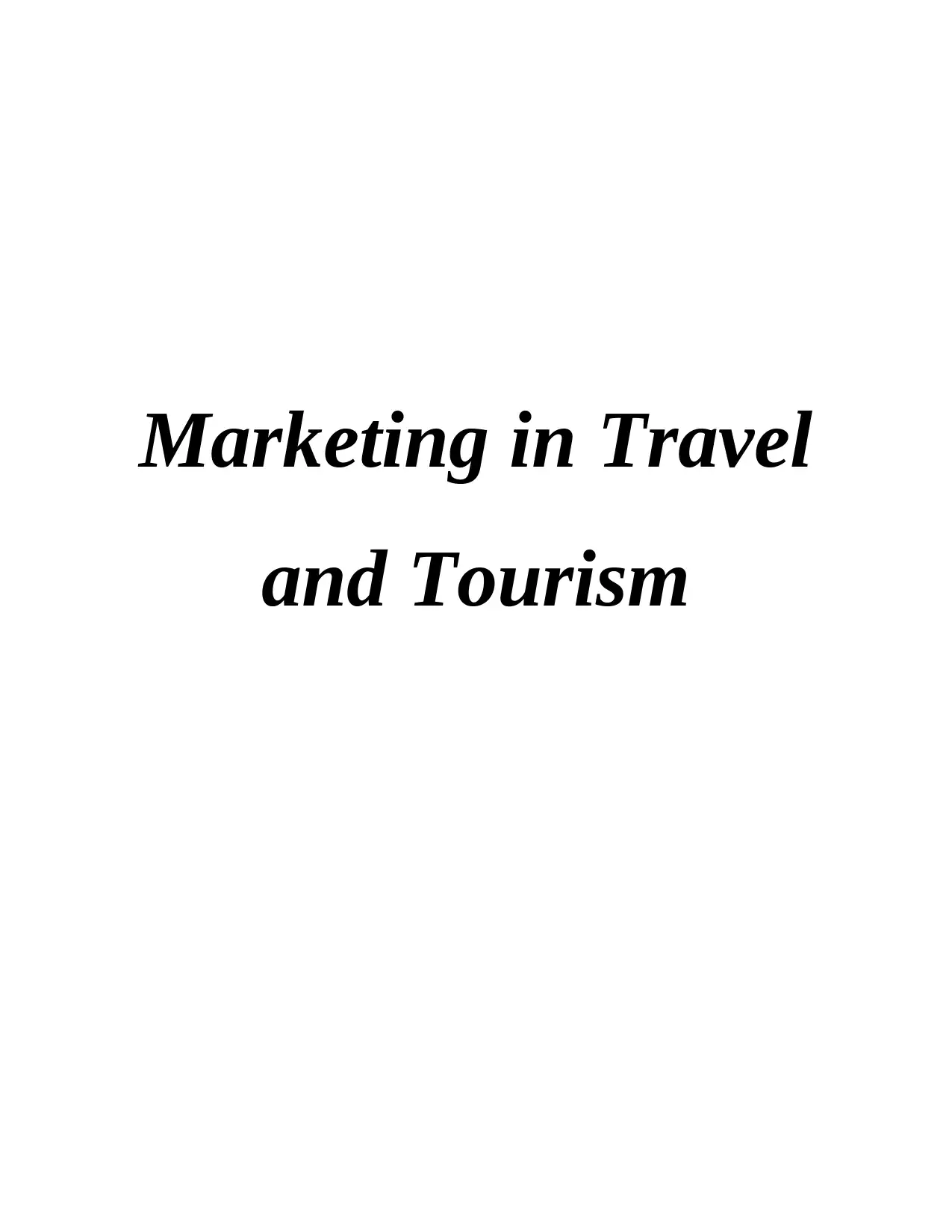
Marketing in Travel
and Tourism
and Tourism
Paraphrase This Document
Need a fresh take? Get an instant paraphrase of this document with our AI Paraphraser
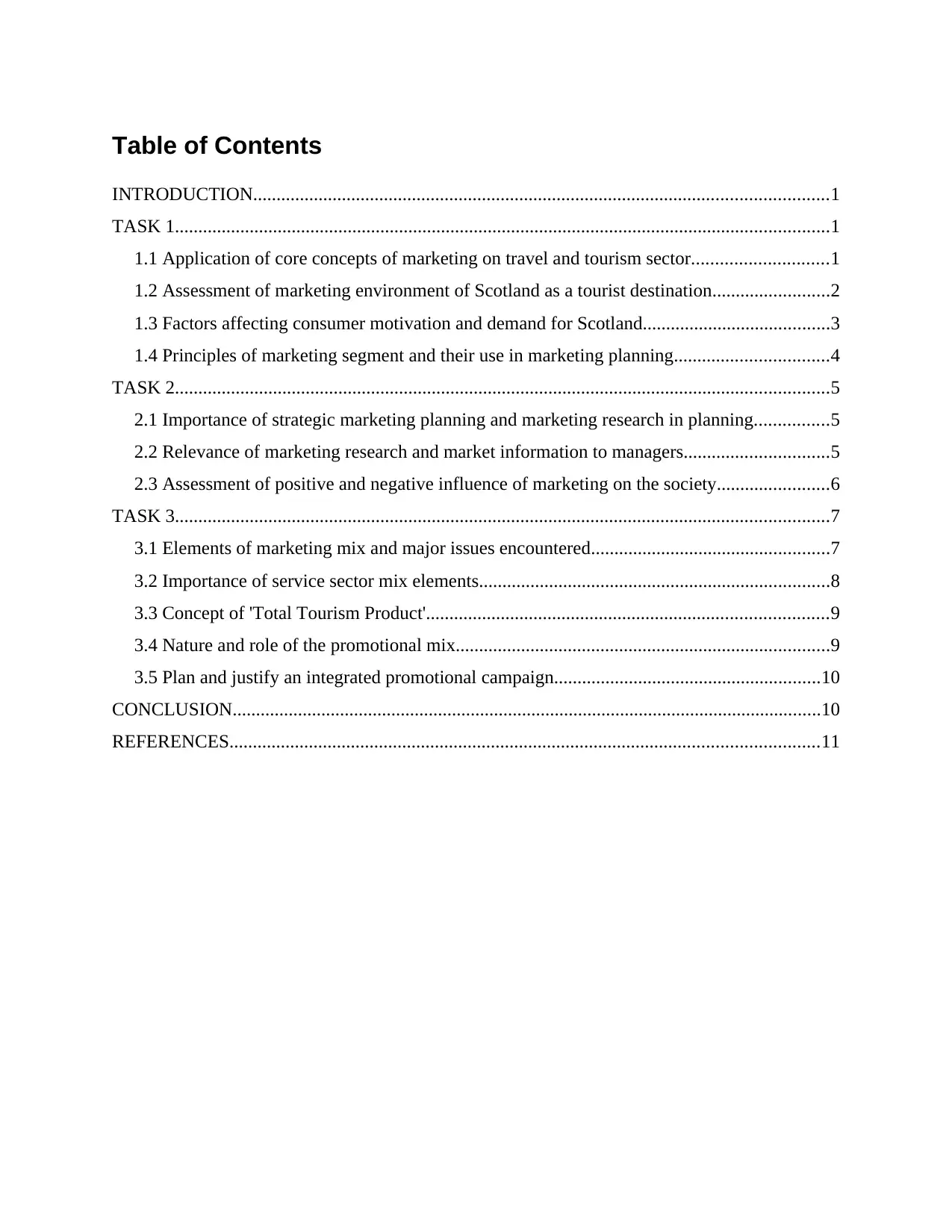
Table of Contents
INTRODUCTION...........................................................................................................................1
TASK 1............................................................................................................................................1
1.1 Application of core concepts of marketing on travel and tourism sector.............................1
1.2 Assessment of marketing environment of Scotland as a tourist destination.........................2
1.3 Factors affecting consumer motivation and demand for Scotland........................................3
1.4 Principles of marketing segment and their use in marketing planning.................................4
TASK 2............................................................................................................................................5
2.1 Importance of strategic marketing planning and marketing research in planning................5
2.2 Relevance of marketing research and market information to managers...............................5
2.3 Assessment of positive and negative influence of marketing on the society........................6
TASK 3............................................................................................................................................7
3.1 Elements of marketing mix and major issues encountered...................................................7
3.2 Importance of service sector mix elements...........................................................................8
3.3 Concept of 'Total Tourism Product'......................................................................................9
3.4 Nature and role of the promotional mix................................................................................9
3.5 Plan and justify an integrated promotional campaign.........................................................10
CONCLUSION..............................................................................................................................10
REFERENCES..............................................................................................................................11
INTRODUCTION...........................................................................................................................1
TASK 1............................................................................................................................................1
1.1 Application of core concepts of marketing on travel and tourism sector.............................1
1.2 Assessment of marketing environment of Scotland as a tourist destination.........................2
1.3 Factors affecting consumer motivation and demand for Scotland........................................3
1.4 Principles of marketing segment and their use in marketing planning.................................4
TASK 2............................................................................................................................................5
2.1 Importance of strategic marketing planning and marketing research in planning................5
2.2 Relevance of marketing research and market information to managers...............................5
2.3 Assessment of positive and negative influence of marketing on the society........................6
TASK 3............................................................................................................................................7
3.1 Elements of marketing mix and major issues encountered...................................................7
3.2 Importance of service sector mix elements...........................................................................8
3.3 Concept of 'Total Tourism Product'......................................................................................9
3.4 Nature and role of the promotional mix................................................................................9
3.5 Plan and justify an integrated promotional campaign.........................................................10
CONCLUSION..............................................................................................................................10
REFERENCES..............................................................................................................................11
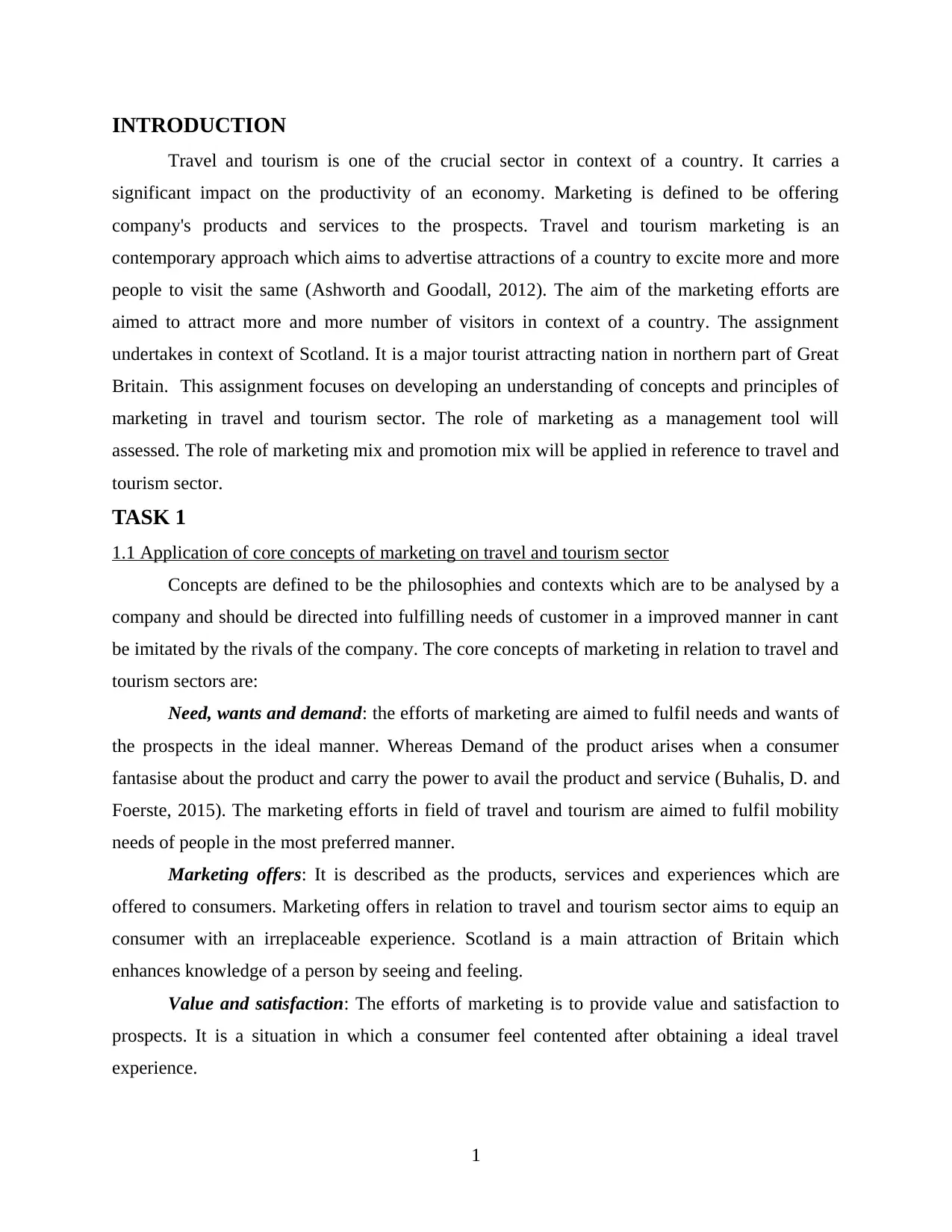
INTRODUCTION
Travel and tourism is one of the crucial sector in context of a country. It carries a
significant impact on the productivity of an economy. Marketing is defined to be offering
company's products and services to the prospects. Travel and tourism marketing is an
contemporary approach which aims to advertise attractions of a country to excite more and more
people to visit the same (Ashworth and Goodall, 2012). The aim of the marketing efforts are
aimed to attract more and more number of visitors in context of a country. The assignment
undertakes in context of Scotland. It is a major tourist attracting nation in northern part of Great
Britain. This assignment focuses on developing an understanding of concepts and principles of
marketing in travel and tourism sector. The role of marketing as a management tool will
assessed. The role of marketing mix and promotion mix will be applied in reference to travel and
tourism sector.
TASK 1
1.1 Application of core concepts of marketing on travel and tourism sector
Concepts are defined to be the philosophies and contexts which are to be analysed by a
company and should be directed into fulfilling needs of customer in a improved manner in cant
be imitated by the rivals of the company. The core concepts of marketing in relation to travel and
tourism sectors are:
Need, wants and demand: the efforts of marketing are aimed to fulfil needs and wants of
the prospects in the ideal manner. Whereas Demand of the product arises when a consumer
fantasise about the product and carry the power to avail the product and service (Buhalis, D. and
Foerste, 2015). The marketing efforts in field of travel and tourism are aimed to fulfil mobility
needs of people in the most preferred manner.
Marketing offers: It is described as the products, services and experiences which are
offered to consumers. Marketing offers in relation to travel and tourism sector aims to equip an
consumer with an irreplaceable experience. Scotland is a main attraction of Britain which
enhances knowledge of a person by seeing and feeling.
Value and satisfaction: The efforts of marketing is to provide value and satisfaction to
prospects. It is a situation in which a consumer feel contented after obtaining a ideal travel
experience.
1
Travel and tourism is one of the crucial sector in context of a country. It carries a
significant impact on the productivity of an economy. Marketing is defined to be offering
company's products and services to the prospects. Travel and tourism marketing is an
contemporary approach which aims to advertise attractions of a country to excite more and more
people to visit the same (Ashworth and Goodall, 2012). The aim of the marketing efforts are
aimed to attract more and more number of visitors in context of a country. The assignment
undertakes in context of Scotland. It is a major tourist attracting nation in northern part of Great
Britain. This assignment focuses on developing an understanding of concepts and principles of
marketing in travel and tourism sector. The role of marketing as a management tool will
assessed. The role of marketing mix and promotion mix will be applied in reference to travel and
tourism sector.
TASK 1
1.1 Application of core concepts of marketing on travel and tourism sector
Concepts are defined to be the philosophies and contexts which are to be analysed by a
company and should be directed into fulfilling needs of customer in a improved manner in cant
be imitated by the rivals of the company. The core concepts of marketing in relation to travel and
tourism sectors are:
Need, wants and demand: the efforts of marketing are aimed to fulfil needs and wants of
the prospects in the ideal manner. Whereas Demand of the product arises when a consumer
fantasise about the product and carry the power to avail the product and service (Buhalis, D. and
Foerste, 2015). The marketing efforts in field of travel and tourism are aimed to fulfil mobility
needs of people in the most preferred manner.
Marketing offers: It is described as the products, services and experiences which are
offered to consumers. Marketing offers in relation to travel and tourism sector aims to equip an
consumer with an irreplaceable experience. Scotland is a main attraction of Britain which
enhances knowledge of a person by seeing and feeling.
Value and satisfaction: The efforts of marketing is to provide value and satisfaction to
prospects. It is a situation in which a consumer feel contented after obtaining a ideal travel
experience.
1
⊘ This is a preview!⊘
Do you want full access?
Subscribe today to unlock all pages.

Trusted by 1+ million students worldwide

Exchanges, Transaction and relationship: Exchange is defined to be ideal approach
when one is looking to satisfy his needs and desires. In this concept of marketing, exchange
stands crucial. The prospects can have a wonderful travelling experience by paying a defined
amount of money for the same.
Relationship and Networking: the efforts and activities of marketing are aimed at
building and enhancing customer relations. The customer are provided with a satisfying
experience so that better relation results in higher profitability of business. The marketing
department of a company ensures that long term relation are built and maintained with a
customer.
1.2 Assessment of marketing environment of Scotland as a tourist destination
Scotland is a most visited country in terms of travellers. The efforts of the Scottish
government is to promote tourism in the country so that it carries a positive benefits on the
economy of the country. The research conducted proved that tourism sector of the country
employs around 200,000 people and garnered a revenue of approximately 4 billion euros. This
European nation have proved stability of its operation despite suffering from economic recession
and cut throat competition. The government of the country had undertaken various project which
aims to preserve its cultural and social heritage of the nation.
Marketing environment of the country is favourable. The adoption of best fit approach of
marketing have shows positive results to tourism sector of the country. The efforts are on
international marketing as they tend to create a difference in the financial sector and stays longer
when compared with local tourists (When Is The Best Time To Visit Scotland?, 2017). The
research conducted stated that 36% of the total funds are supported by the international visitors.
The favouritism of marketing environment aims to increase visitors in a nation so to create
positive outcomes in economy. Holiday experiences are advertised to tempt people into visiting a
nation. Marketing researches are conducted on regular basis and efforts are made to improve
quality of experience of visitors in Scotland. The various marketing strategy which are adopted
are online marketing, distribution strategy and partnerships with other organisations.
2
when one is looking to satisfy his needs and desires. In this concept of marketing, exchange
stands crucial. The prospects can have a wonderful travelling experience by paying a defined
amount of money for the same.
Relationship and Networking: the efforts and activities of marketing are aimed at
building and enhancing customer relations. The customer are provided with a satisfying
experience so that better relation results in higher profitability of business. The marketing
department of a company ensures that long term relation are built and maintained with a
customer.
1.2 Assessment of marketing environment of Scotland as a tourist destination
Scotland is a most visited country in terms of travellers. The efforts of the Scottish
government is to promote tourism in the country so that it carries a positive benefits on the
economy of the country. The research conducted proved that tourism sector of the country
employs around 200,000 people and garnered a revenue of approximately 4 billion euros. This
European nation have proved stability of its operation despite suffering from economic recession
and cut throat competition. The government of the country had undertaken various project which
aims to preserve its cultural and social heritage of the nation.
Marketing environment of the country is favourable. The adoption of best fit approach of
marketing have shows positive results to tourism sector of the country. The efforts are on
international marketing as they tend to create a difference in the financial sector and stays longer
when compared with local tourists (When Is The Best Time To Visit Scotland?, 2017). The
research conducted stated that 36% of the total funds are supported by the international visitors.
The favouritism of marketing environment aims to increase visitors in a nation so to create
positive outcomes in economy. Holiday experiences are advertised to tempt people into visiting a
nation. Marketing researches are conducted on regular basis and efforts are made to improve
quality of experience of visitors in Scotland. The various marketing strategy which are adopted
are online marketing, distribution strategy and partnerships with other organisations.
2
Paraphrase This Document
Need a fresh take? Get an instant paraphrase of this document with our AI Paraphraser
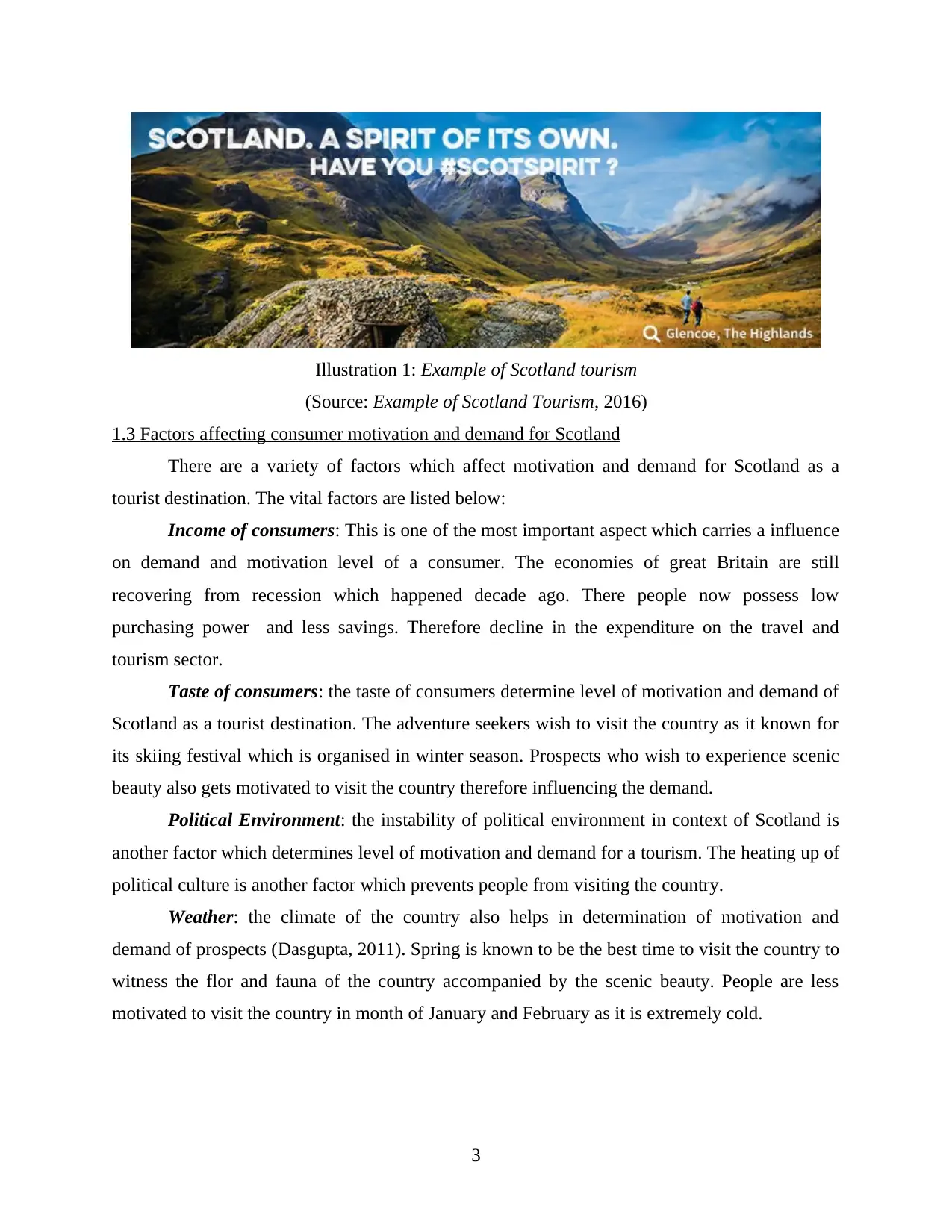
(Source: Example of Scotland Tourism, 2016)
1.3 Factors affecting consumer motivation and demand for Scotland
There are a variety of factors which affect motivation and demand for Scotland as a
tourist destination. The vital factors are listed below:
Income of consumers: This is one of the most important aspect which carries a influence
on demand and motivation level of a consumer. The economies of great Britain are still
recovering from recession which happened decade ago. There people now possess low
purchasing power and less savings. Therefore decline in the expenditure on the travel and
tourism sector.
Taste of consumers: the taste of consumers determine level of motivation and demand of
Scotland as a tourist destination. The adventure seekers wish to visit the country as it known for
its skiing festival which is organised in winter season. Prospects who wish to experience scenic
beauty also gets motivated to visit the country therefore influencing the demand.
Political Environment: the instability of political environment in context of Scotland is
another factor which determines level of motivation and demand for a tourism. The heating up of
political culture is another factor which prevents people from visiting the country.
Weather: the climate of the country also helps in determination of motivation and
demand of prospects (Dasgupta, 2011). Spring is known to be the best time to visit the country to
witness the flor and fauna of the country accompanied by the scenic beauty. People are less
motivated to visit the country in month of January and February as it is extremely cold.
3
Illustration 1: Example of Scotland tourism
1.3 Factors affecting consumer motivation and demand for Scotland
There are a variety of factors which affect motivation and demand for Scotland as a
tourist destination. The vital factors are listed below:
Income of consumers: This is one of the most important aspect which carries a influence
on demand and motivation level of a consumer. The economies of great Britain are still
recovering from recession which happened decade ago. There people now possess low
purchasing power and less savings. Therefore decline in the expenditure on the travel and
tourism sector.
Taste of consumers: the taste of consumers determine level of motivation and demand of
Scotland as a tourist destination. The adventure seekers wish to visit the country as it known for
its skiing festival which is organised in winter season. Prospects who wish to experience scenic
beauty also gets motivated to visit the country therefore influencing the demand.
Political Environment: the instability of political environment in context of Scotland is
another factor which determines level of motivation and demand for a tourism. The heating up of
political culture is another factor which prevents people from visiting the country.
Weather: the climate of the country also helps in determination of motivation and
demand of prospects (Dasgupta, 2011). Spring is known to be the best time to visit the country to
witness the flor and fauna of the country accompanied by the scenic beauty. People are less
motivated to visit the country in month of January and February as it is extremely cold.
3
Illustration 1: Example of Scotland tourism
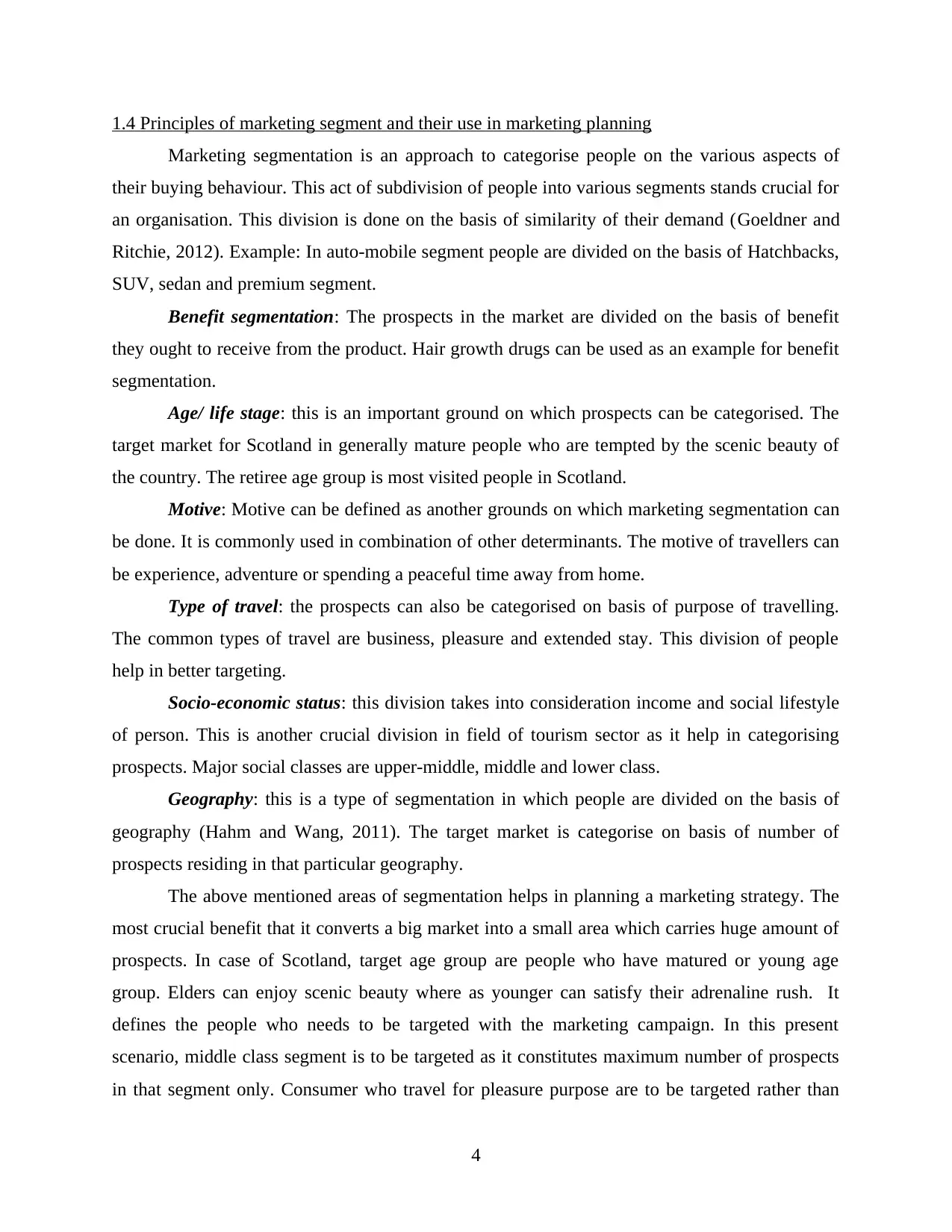
1.4 Principles of marketing segment and their use in marketing planning
Marketing segmentation is an approach to categorise people on the various aspects of
their buying behaviour. This act of subdivision of people into various segments stands crucial for
an organisation. This division is done on the basis of similarity of their demand (Goeldner and
Ritchie, 2012). Example: In auto-mobile segment people are divided on the basis of Hatchbacks,
SUV, sedan and premium segment.
Benefit segmentation: The prospects in the market are divided on the basis of benefit
they ought to receive from the product. Hair growth drugs can be used as an example for benefit
segmentation.
Age/ life stage: this is an important ground on which prospects can be categorised. The
target market for Scotland in generally mature people who are tempted by the scenic beauty of
the country. The retiree age group is most visited people in Scotland.
Motive: Motive can be defined as another grounds on which marketing segmentation can
be done. It is commonly used in combination of other determinants. The motive of travellers can
be experience, adventure or spending a peaceful time away from home.
Type of travel: the prospects can also be categorised on basis of purpose of travelling.
The common types of travel are business, pleasure and extended stay. This division of people
help in better targeting.
Socio-economic status: this division takes into consideration income and social lifestyle
of person. This is another crucial division in field of tourism sector as it help in categorising
prospects. Major social classes are upper-middle, middle and lower class.
Geography: this is a type of segmentation in which people are divided on the basis of
geography (Hahm and Wang, 2011). The target market is categorise on basis of number of
prospects residing in that particular geography.
The above mentioned areas of segmentation helps in planning a marketing strategy. The
most crucial benefit that it converts a big market into a small area which carries huge amount of
prospects. In case of Scotland, target age group are people who have matured or young age
group. Elders can enjoy scenic beauty where as younger can satisfy their adrenaline rush. It
defines the people who needs to be targeted with the marketing campaign. In this present
scenario, middle class segment is to be targeted as it constitutes maximum number of prospects
in that segment only. Consumer who travel for pleasure purpose are to be targeted rather than
4
Marketing segmentation is an approach to categorise people on the various aspects of
their buying behaviour. This act of subdivision of people into various segments stands crucial for
an organisation. This division is done on the basis of similarity of their demand (Goeldner and
Ritchie, 2012). Example: In auto-mobile segment people are divided on the basis of Hatchbacks,
SUV, sedan and premium segment.
Benefit segmentation: The prospects in the market are divided on the basis of benefit
they ought to receive from the product. Hair growth drugs can be used as an example for benefit
segmentation.
Age/ life stage: this is an important ground on which prospects can be categorised. The
target market for Scotland in generally mature people who are tempted by the scenic beauty of
the country. The retiree age group is most visited people in Scotland.
Motive: Motive can be defined as another grounds on which marketing segmentation can
be done. It is commonly used in combination of other determinants. The motive of travellers can
be experience, adventure or spending a peaceful time away from home.
Type of travel: the prospects can also be categorised on basis of purpose of travelling.
The common types of travel are business, pleasure and extended stay. This division of people
help in better targeting.
Socio-economic status: this division takes into consideration income and social lifestyle
of person. This is another crucial division in field of tourism sector as it help in categorising
prospects. Major social classes are upper-middle, middle and lower class.
Geography: this is a type of segmentation in which people are divided on the basis of
geography (Hahm and Wang, 2011). The target market is categorise on basis of number of
prospects residing in that particular geography.
The above mentioned areas of segmentation helps in planning a marketing strategy. The
most crucial benefit that it converts a big market into a small area which carries huge amount of
prospects. In case of Scotland, target age group are people who have matured or young age
group. Elders can enjoy scenic beauty where as younger can satisfy their adrenaline rush. It
defines the people who needs to be targeted with the marketing campaign. In this present
scenario, middle class segment is to be targeted as it constitutes maximum number of prospects
in that segment only. Consumer who travel for pleasure purpose are to be targeted rather than
4
⊘ This is a preview!⊘
Do you want full access?
Subscribe today to unlock all pages.

Trusted by 1+ million students worldwide
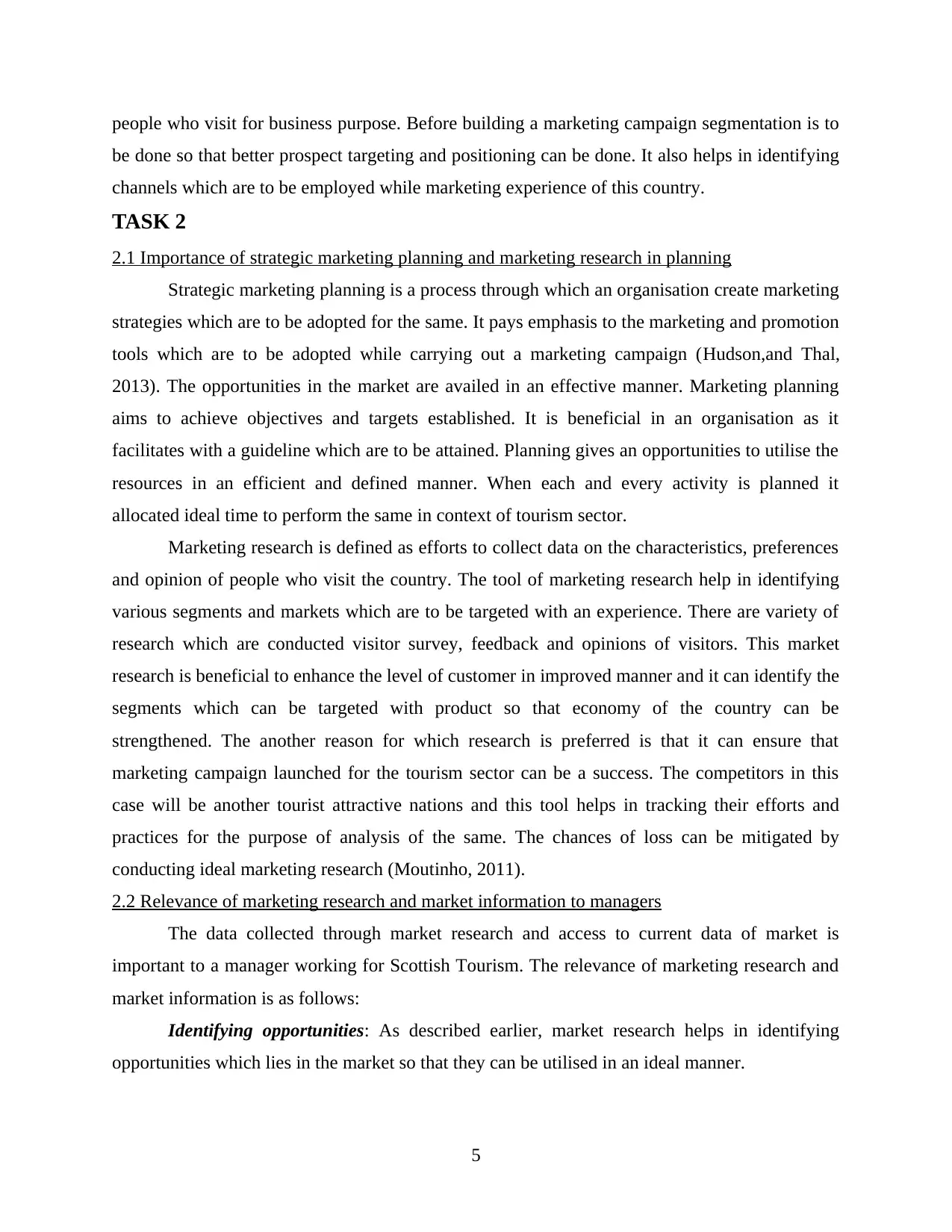
people who visit for business purpose. Before building a marketing campaign segmentation is to
be done so that better prospect targeting and positioning can be done. It also helps in identifying
channels which are to be employed while marketing experience of this country.
TASK 2
2.1 Importance of strategic marketing planning and marketing research in planning
Strategic marketing planning is a process through which an organisation create marketing
strategies which are to be adopted for the same. It pays emphasis to the marketing and promotion
tools which are to be adopted while carrying out a marketing campaign (Hudson,and Thal,
2013). The opportunities in the market are availed in an effective manner. Marketing planning
aims to achieve objectives and targets established. It is beneficial in an organisation as it
facilitates with a guideline which are to be attained. Planning gives an opportunities to utilise the
resources in an efficient and defined manner. When each and every activity is planned it
allocated ideal time to perform the same in context of tourism sector.
Marketing research is defined as efforts to collect data on the characteristics, preferences
and opinion of people who visit the country. The tool of marketing research help in identifying
various segments and markets which are to be targeted with an experience. There are variety of
research which are conducted visitor survey, feedback and opinions of visitors. This market
research is beneficial to enhance the level of customer in improved manner and it can identify the
segments which can be targeted with product so that economy of the country can be
strengthened. The another reason for which research is preferred is that it can ensure that
marketing campaign launched for the tourism sector can be a success. The competitors in this
case will be another tourist attractive nations and this tool helps in tracking their efforts and
practices for the purpose of analysis of the same. The chances of loss can be mitigated by
conducting ideal marketing research (Moutinho, 2011).
2.2 Relevance of marketing research and market information to managers
The data collected through market research and access to current data of market is
important to a manager working for Scottish Tourism. The relevance of marketing research and
market information is as follows:
Identifying opportunities: As described earlier, market research helps in identifying
opportunities which lies in the market so that they can be utilised in an ideal manner.
5
be done so that better prospect targeting and positioning can be done. It also helps in identifying
channels which are to be employed while marketing experience of this country.
TASK 2
2.1 Importance of strategic marketing planning and marketing research in planning
Strategic marketing planning is a process through which an organisation create marketing
strategies which are to be adopted for the same. It pays emphasis to the marketing and promotion
tools which are to be adopted while carrying out a marketing campaign (Hudson,and Thal,
2013). The opportunities in the market are availed in an effective manner. Marketing planning
aims to achieve objectives and targets established. It is beneficial in an organisation as it
facilitates with a guideline which are to be attained. Planning gives an opportunities to utilise the
resources in an efficient and defined manner. When each and every activity is planned it
allocated ideal time to perform the same in context of tourism sector.
Marketing research is defined as efforts to collect data on the characteristics, preferences
and opinion of people who visit the country. The tool of marketing research help in identifying
various segments and markets which are to be targeted with an experience. There are variety of
research which are conducted visitor survey, feedback and opinions of visitors. This market
research is beneficial to enhance the level of customer in improved manner and it can identify the
segments which can be targeted with product so that economy of the country can be
strengthened. The another reason for which research is preferred is that it can ensure that
marketing campaign launched for the tourism sector can be a success. The competitors in this
case will be another tourist attractive nations and this tool helps in tracking their efforts and
practices for the purpose of analysis of the same. The chances of loss can be mitigated by
conducting ideal marketing research (Moutinho, 2011).
2.2 Relevance of marketing research and market information to managers
The data collected through market research and access to current data of market is
important to a manager working for Scottish Tourism. The relevance of marketing research and
market information is as follows:
Identifying opportunities: As described earlier, market research helps in identifying
opportunities which lies in the market so that they can be utilised in an ideal manner.
5
Paraphrase This Document
Need a fresh take? Get an instant paraphrase of this document with our AI Paraphraser
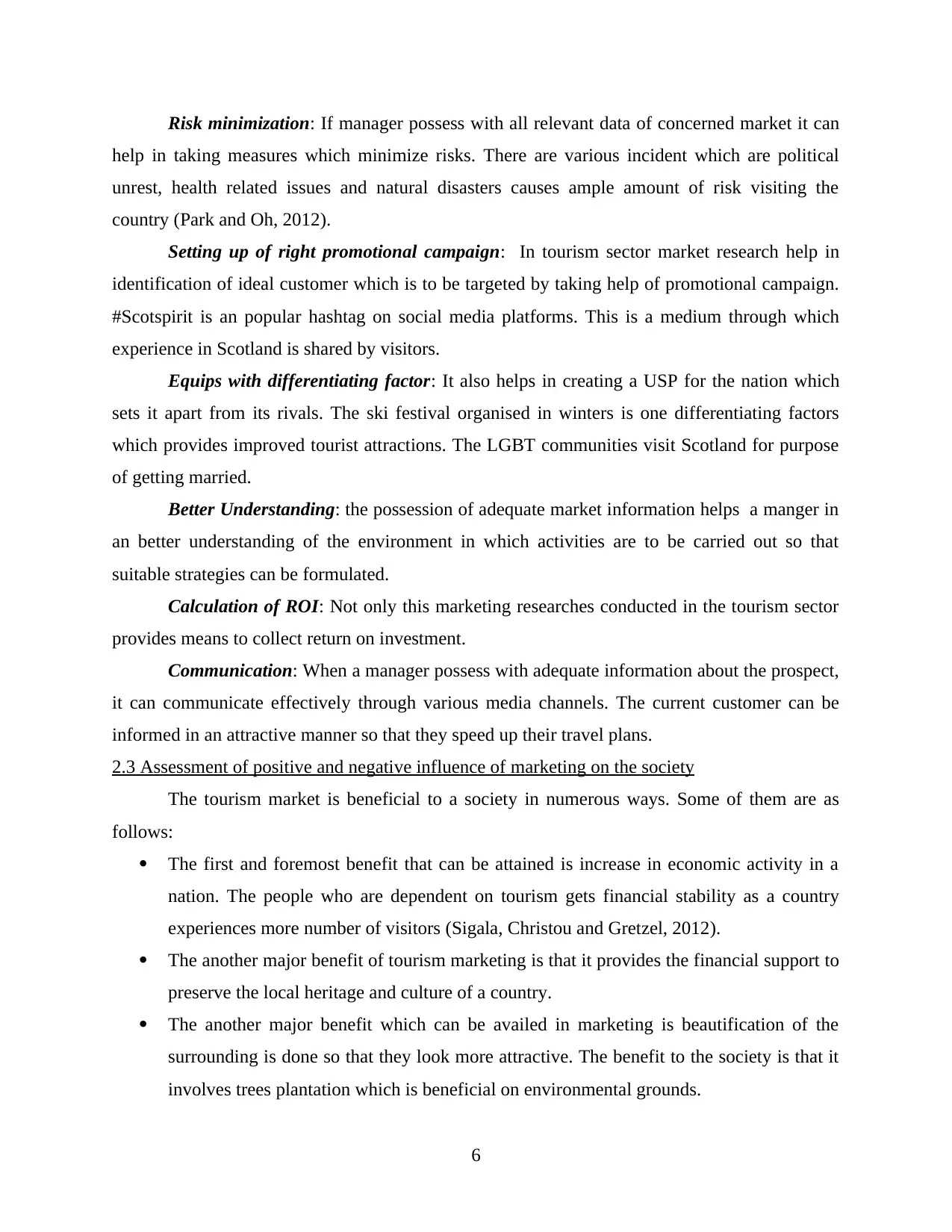
Risk minimization: If manager possess with all relevant data of concerned market it can
help in taking measures which minimize risks. There are various incident which are political
unrest, health related issues and natural disasters causes ample amount of risk visiting the
country (Park and Oh, 2012).
Setting up of right promotional campaign: In tourism sector market research help in
identification of ideal customer which is to be targeted by taking help of promotional campaign.
#Scotspirit is an popular hashtag on social media platforms. This is a medium through which
experience in Scotland is shared by visitors.
Equips with differentiating factor: It also helps in creating a USP for the nation which
sets it apart from its rivals. The ski festival organised in winters is one differentiating factors
which provides improved tourist attractions. The LGBT communities visit Scotland for purpose
of getting married.
Better Understanding: the possession of adequate market information helps a manger in
an better understanding of the environment in which activities are to be carried out so that
suitable strategies can be formulated.
Calculation of ROI: Not only this marketing researches conducted in the tourism sector
provides means to collect return on investment.
Communication: When a manager possess with adequate information about the prospect,
it can communicate effectively through various media channels. The current customer can be
informed in an attractive manner so that they speed up their travel plans.
2.3 Assessment of positive and negative influence of marketing on the society
The tourism market is beneficial to a society in numerous ways. Some of them are as
follows:
The first and foremost benefit that can be attained is increase in economic activity in a
nation. The people who are dependent on tourism gets financial stability as a country
experiences more number of visitors (Sigala, Christou and Gretzel, 2012).
The another major benefit of tourism marketing is that it provides the financial support to
preserve the local heritage and culture of a country.
The another major benefit which can be availed in marketing is beautification of the
surrounding is done so that they look more attractive. The benefit to the society is that it
involves trees plantation which is beneficial on environmental grounds.
6
help in taking measures which minimize risks. There are various incident which are political
unrest, health related issues and natural disasters causes ample amount of risk visiting the
country (Park and Oh, 2012).
Setting up of right promotional campaign: In tourism sector market research help in
identification of ideal customer which is to be targeted by taking help of promotional campaign.
#Scotspirit is an popular hashtag on social media platforms. This is a medium through which
experience in Scotland is shared by visitors.
Equips with differentiating factor: It also helps in creating a USP for the nation which
sets it apart from its rivals. The ski festival organised in winters is one differentiating factors
which provides improved tourist attractions. The LGBT communities visit Scotland for purpose
of getting married.
Better Understanding: the possession of adequate market information helps a manger in
an better understanding of the environment in which activities are to be carried out so that
suitable strategies can be formulated.
Calculation of ROI: Not only this marketing researches conducted in the tourism sector
provides means to collect return on investment.
Communication: When a manager possess with adequate information about the prospect,
it can communicate effectively through various media channels. The current customer can be
informed in an attractive manner so that they speed up their travel plans.
2.3 Assessment of positive and negative influence of marketing on the society
The tourism market is beneficial to a society in numerous ways. Some of them are as
follows:
The first and foremost benefit that can be attained is increase in economic activity in a
nation. The people who are dependent on tourism gets financial stability as a country
experiences more number of visitors (Sigala, Christou and Gretzel, 2012).
The another major benefit of tourism marketing is that it provides the financial support to
preserve the local heritage and culture of a country.
The another major benefit which can be availed in marketing is beautification of the
surrounding is done so that they look more attractive. The benefit to the society is that it
involves trees plantation which is beneficial on environmental grounds.
6
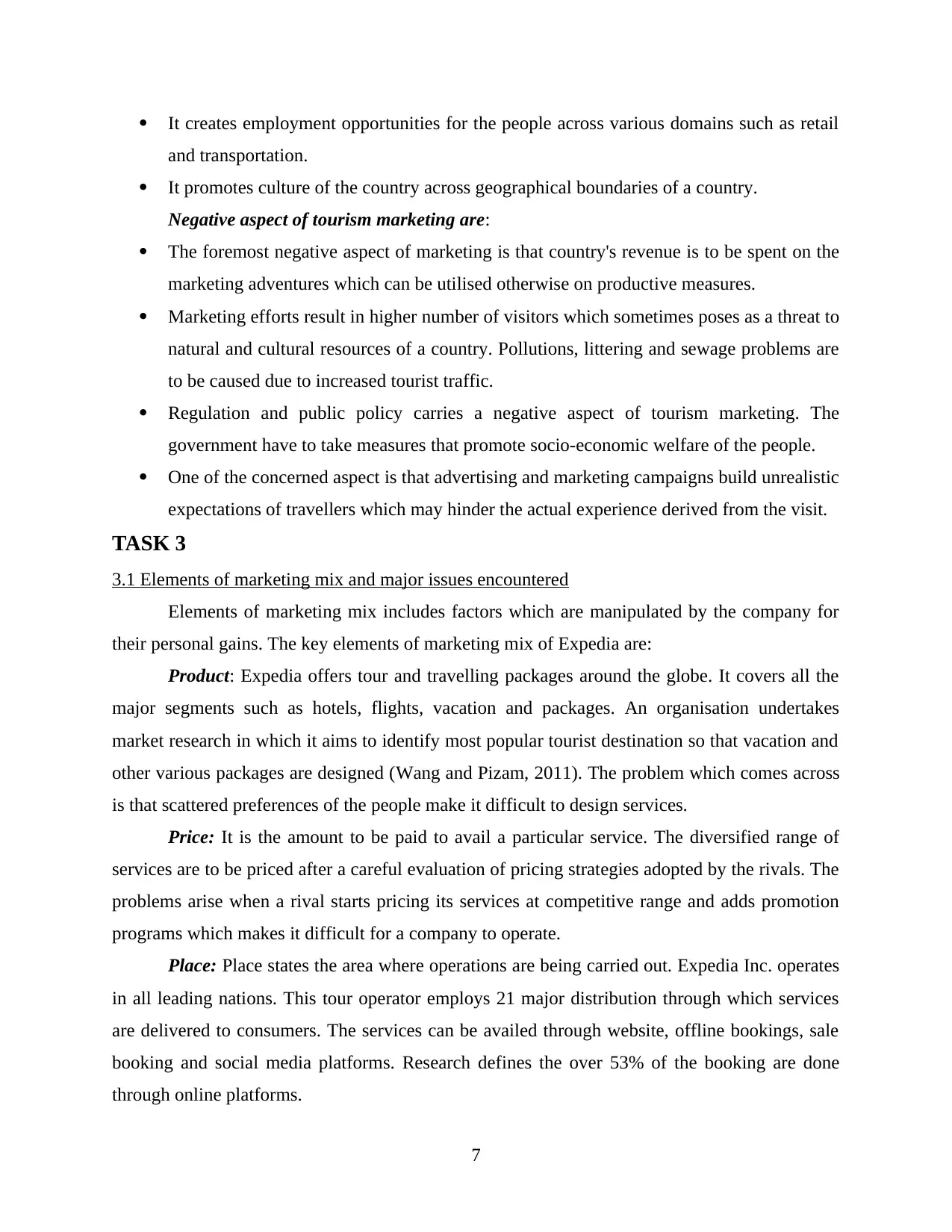
It creates employment opportunities for the people across various domains such as retail
and transportation.
It promotes culture of the country across geographical boundaries of a country.
Negative aspect of tourism marketing are:
The foremost negative aspect of marketing is that country's revenue is to be spent on the
marketing adventures which can be utilised otherwise on productive measures.
Marketing efforts result in higher number of visitors which sometimes poses as a threat to
natural and cultural resources of a country. Pollutions, littering and sewage problems are
to be caused due to increased tourist traffic.
Regulation and public policy carries a negative aspect of tourism marketing. The
government have to take measures that promote socio-economic welfare of the people.
One of the concerned aspect is that advertising and marketing campaigns build unrealistic
expectations of travellers which may hinder the actual experience derived from the visit.
TASK 3
3.1 Elements of marketing mix and major issues encountered
Elements of marketing mix includes factors which are manipulated by the company for
their personal gains. The key elements of marketing mix of Expedia are:
Product: Expedia offers tour and travelling packages around the globe. It covers all the
major segments such as hotels, flights, vacation and packages. An organisation undertakes
market research in which it aims to identify most popular tourist destination so that vacation and
other various packages are designed (Wang and Pizam, 2011). The problem which comes across
is that scattered preferences of the people make it difficult to design services.
Price: It is the amount to be paid to avail a particular service. The diversified range of
services are to be priced after a careful evaluation of pricing strategies adopted by the rivals. The
problems arise when a rival starts pricing its services at competitive range and adds promotion
programs which makes it difficult for a company to operate.
Place: Place states the area where operations are being carried out. Expedia Inc. operates
in all leading nations. This tour operator employs 21 major distribution through which services
are delivered to consumers. The services can be availed through website, offline bookings, sale
booking and social media platforms. Research defines the over 53% of the booking are done
through online platforms.
7
and transportation.
It promotes culture of the country across geographical boundaries of a country.
Negative aspect of tourism marketing are:
The foremost negative aspect of marketing is that country's revenue is to be spent on the
marketing adventures which can be utilised otherwise on productive measures.
Marketing efforts result in higher number of visitors which sometimes poses as a threat to
natural and cultural resources of a country. Pollutions, littering and sewage problems are
to be caused due to increased tourist traffic.
Regulation and public policy carries a negative aspect of tourism marketing. The
government have to take measures that promote socio-economic welfare of the people.
One of the concerned aspect is that advertising and marketing campaigns build unrealistic
expectations of travellers which may hinder the actual experience derived from the visit.
TASK 3
3.1 Elements of marketing mix and major issues encountered
Elements of marketing mix includes factors which are manipulated by the company for
their personal gains. The key elements of marketing mix of Expedia are:
Product: Expedia offers tour and travelling packages around the globe. It covers all the
major segments such as hotels, flights, vacation and packages. An organisation undertakes
market research in which it aims to identify most popular tourist destination so that vacation and
other various packages are designed (Wang and Pizam, 2011). The problem which comes across
is that scattered preferences of the people make it difficult to design services.
Price: It is the amount to be paid to avail a particular service. The diversified range of
services are to be priced after a careful evaluation of pricing strategies adopted by the rivals. The
problems arise when a rival starts pricing its services at competitive range and adds promotion
programs which makes it difficult for a company to operate.
Place: Place states the area where operations are being carried out. Expedia Inc. operates
in all leading nations. This tour operator employs 21 major distribution through which services
are delivered to consumers. The services can be availed through website, offline bookings, sale
booking and social media platforms. Research defines the over 53% of the booking are done
through online platforms.
7
⊘ This is a preview!⊘
Do you want full access?
Subscribe today to unlock all pages.

Trusted by 1+ million students worldwide

Promotion: this tour operator employs discounting and voucher to influences sales of
services. In this competitive market where Trip advisor and Airbnb are a step ahead in providing
discounts to the consumers. The problem arises when such companies provide heavy discount to
attract customer and cited organisation struggles to provide the same to travellers.
3.2 Importance of service sector mix elements
The elements of service sector element can also be mentioned by the name of extended
marketing mix. In addition to the 4P's of product, people process and physical evidence are
added to enhance the manner in which services are rendered to consumers.
(Source: Extended Marketing Mix, 2017)
Importance of marketing mix is as follows:
Creation of clean marketing mix: the first importance of services marketing mix is that it
covers elements which are linked to each other. The compatibility between these elements help
in progression of the supply chain for the company.
Guides to business development: the consideration to each and every element of
marketing mix ensures business operations. The process in elements aims to process in which
business process are carried out.
Differentiation: the through understanding of the marketing mix ensures that
differentiated service is delivered to consumers. Strengthening each element will help in
differentiating services of the consumers from its rivals. Expedia can strengthen its promotion in
comparison with its rival to create differentiation.
Enhances dynamism: It ensures that a company have a detailed understanding of the
various elements which ensures that it maintains a certain level of agility.
8
Illustration 2: Extended marketing mix
services. In this competitive market where Trip advisor and Airbnb are a step ahead in providing
discounts to the consumers. The problem arises when such companies provide heavy discount to
attract customer and cited organisation struggles to provide the same to travellers.
3.2 Importance of service sector mix elements
The elements of service sector element can also be mentioned by the name of extended
marketing mix. In addition to the 4P's of product, people process and physical evidence are
added to enhance the manner in which services are rendered to consumers.
(Source: Extended Marketing Mix, 2017)
Importance of marketing mix is as follows:
Creation of clean marketing mix: the first importance of services marketing mix is that it
covers elements which are linked to each other. The compatibility between these elements help
in progression of the supply chain for the company.
Guides to business development: the consideration to each and every element of
marketing mix ensures business operations. The process in elements aims to process in which
business process are carried out.
Differentiation: the through understanding of the marketing mix ensures that
differentiated service is delivered to consumers. Strengthening each element will help in
differentiating services of the consumers from its rivals. Expedia can strengthen its promotion in
comparison with its rival to create differentiation.
Enhances dynamism: It ensures that a company have a detailed understanding of the
various elements which ensures that it maintains a certain level of agility.
8
Illustration 2: Extended marketing mix
Paraphrase This Document
Need a fresh take? Get an instant paraphrase of this document with our AI Paraphraser
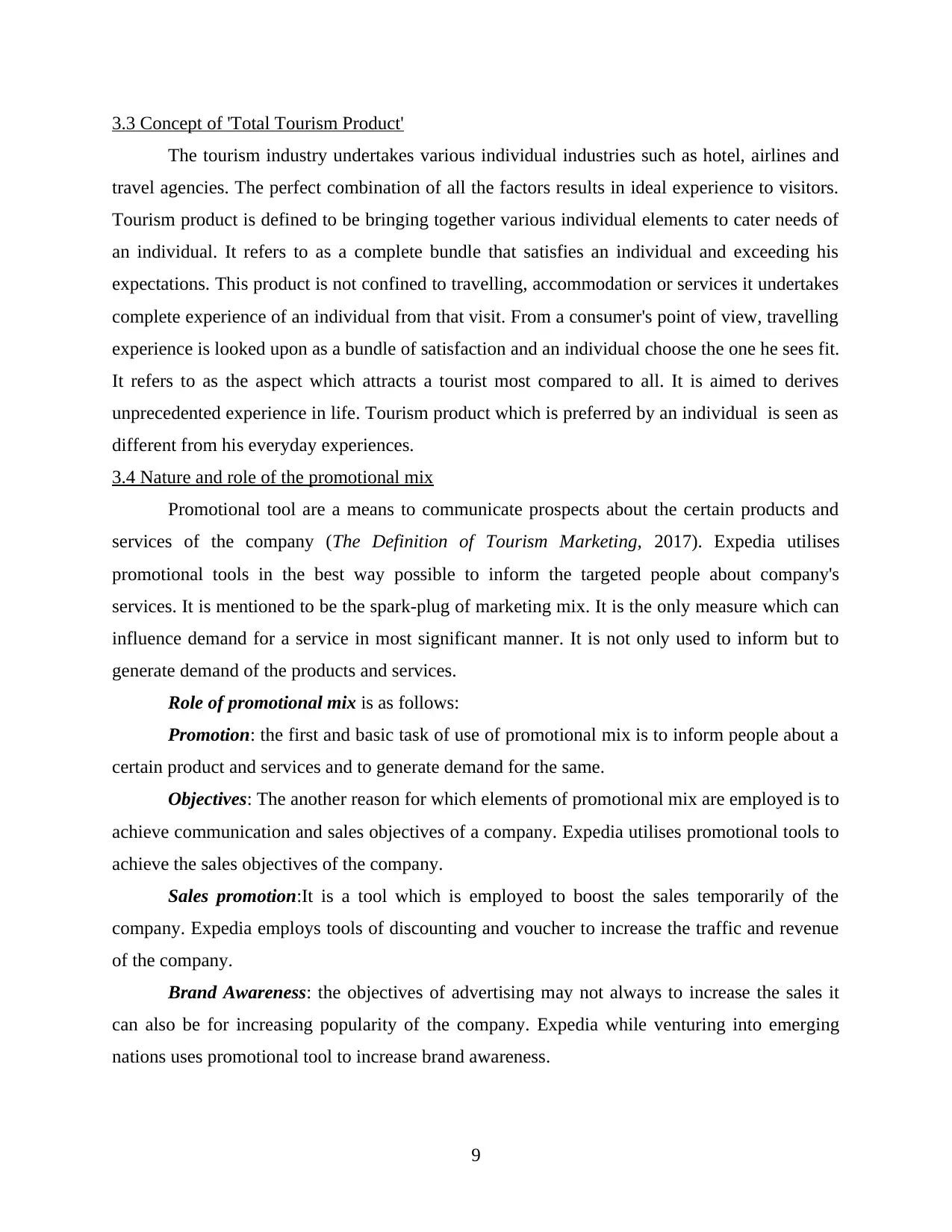
3.3 Concept of 'Total Tourism Product'
The tourism industry undertakes various individual industries such as hotel, airlines and
travel agencies. The perfect combination of all the factors results in ideal experience to visitors.
Tourism product is defined to be bringing together various individual elements to cater needs of
an individual. It refers to as a complete bundle that satisfies an individual and exceeding his
expectations. This product is not confined to travelling, accommodation or services it undertakes
complete experience of an individual from that visit. From a consumer's point of view, travelling
experience is looked upon as a bundle of satisfaction and an individual choose the one he sees fit.
It refers to as the aspect which attracts a tourist most compared to all. It is aimed to derives
unprecedented experience in life. Tourism product which is preferred by an individual is seen as
different from his everyday experiences.
3.4 Nature and role of the promotional mix
Promotional tool are a means to communicate prospects about the certain products and
services of the company (The Definition of Tourism Marketing, 2017). Expedia utilises
promotional tools in the best way possible to inform the targeted people about company's
services. It is mentioned to be the spark-plug of marketing mix. It is the only measure which can
influence demand for a service in most significant manner. It is not only used to inform but to
generate demand of the products and services.
Role of promotional mix is as follows:
Promotion: the first and basic task of use of promotional mix is to inform people about a
certain product and services and to generate demand for the same.
Objectives: The another reason for which elements of promotional mix are employed is to
achieve communication and sales objectives of a company. Expedia utilises promotional tools to
achieve the sales objectives of the company.
Sales promotion:It is a tool which is employed to boost the sales temporarily of the
company. Expedia employs tools of discounting and voucher to increase the traffic and revenue
of the company.
Brand Awareness: the objectives of advertising may not always to increase the sales it
can also be for increasing popularity of the company. Expedia while venturing into emerging
nations uses promotional tool to increase brand awareness.
9
The tourism industry undertakes various individual industries such as hotel, airlines and
travel agencies. The perfect combination of all the factors results in ideal experience to visitors.
Tourism product is defined to be bringing together various individual elements to cater needs of
an individual. It refers to as a complete bundle that satisfies an individual and exceeding his
expectations. This product is not confined to travelling, accommodation or services it undertakes
complete experience of an individual from that visit. From a consumer's point of view, travelling
experience is looked upon as a bundle of satisfaction and an individual choose the one he sees fit.
It refers to as the aspect which attracts a tourist most compared to all. It is aimed to derives
unprecedented experience in life. Tourism product which is preferred by an individual is seen as
different from his everyday experiences.
3.4 Nature and role of the promotional mix
Promotional tool are a means to communicate prospects about the certain products and
services of the company (The Definition of Tourism Marketing, 2017). Expedia utilises
promotional tools in the best way possible to inform the targeted people about company's
services. It is mentioned to be the spark-plug of marketing mix. It is the only measure which can
influence demand for a service in most significant manner. It is not only used to inform but to
generate demand of the products and services.
Role of promotional mix is as follows:
Promotion: the first and basic task of use of promotional mix is to inform people about a
certain product and services and to generate demand for the same.
Objectives: The another reason for which elements of promotional mix are employed is to
achieve communication and sales objectives of a company. Expedia utilises promotional tools to
achieve the sales objectives of the company.
Sales promotion:It is a tool which is employed to boost the sales temporarily of the
company. Expedia employs tools of discounting and voucher to increase the traffic and revenue
of the company.
Brand Awareness: the objectives of advertising may not always to increase the sales it
can also be for increasing popularity of the company. Expedia while venturing into emerging
nations uses promotional tool to increase brand awareness.
9
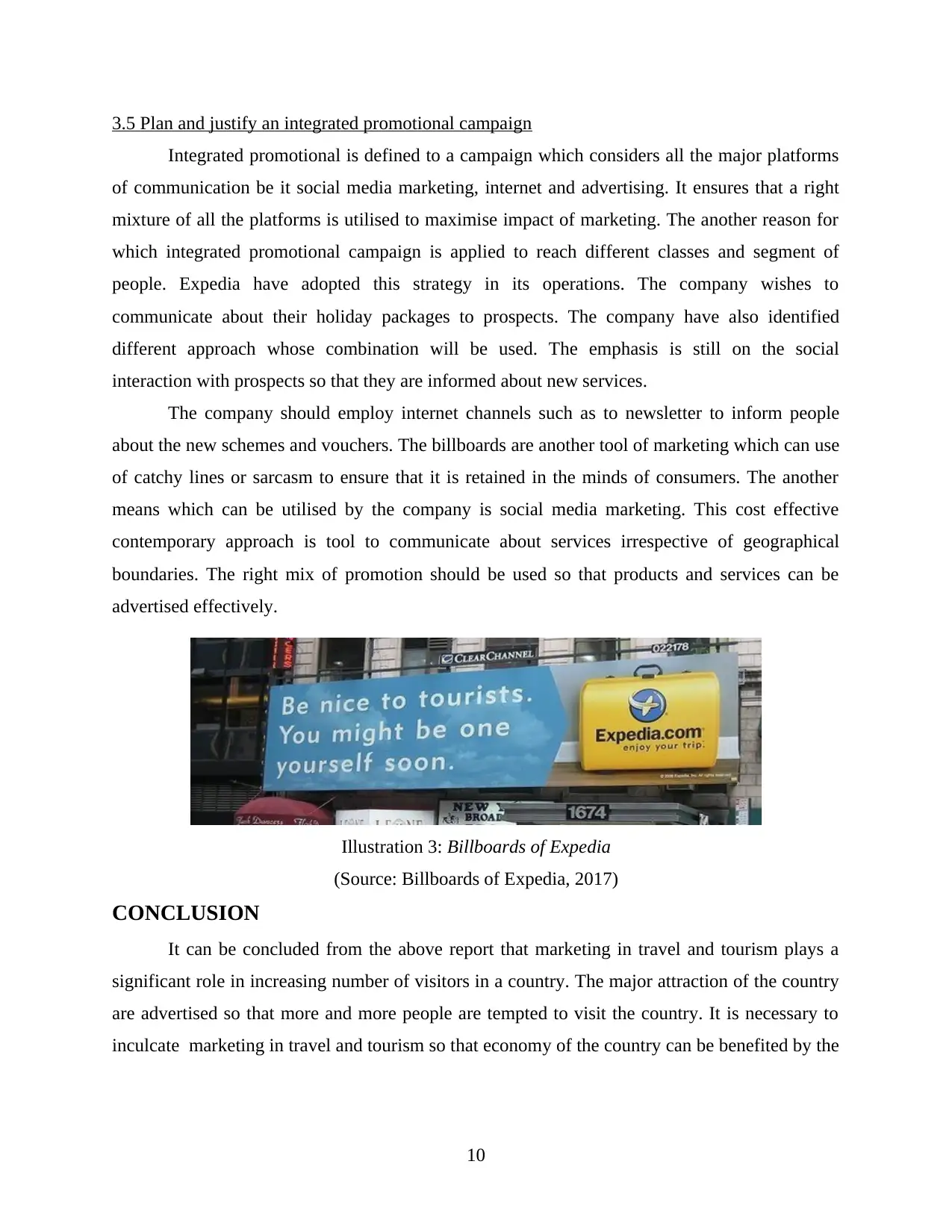
3.5 Plan and justify an integrated promotional campaign
Integrated promotional is defined to a campaign which considers all the major platforms
of communication be it social media marketing, internet and advertising. It ensures that a right
mixture of all the platforms is utilised to maximise impact of marketing. The another reason for
which integrated promotional campaign is applied to reach different classes and segment of
people. Expedia have adopted this strategy in its operations. The company wishes to
communicate about their holiday packages to prospects. The company have also identified
different approach whose combination will be used. The emphasis is still on the social
interaction with prospects so that they are informed about new services.
The company should employ internet channels such as to newsletter to inform people
about the new schemes and vouchers. The billboards are another tool of marketing which can use
of catchy lines or sarcasm to ensure that it is retained in the minds of consumers. The another
means which can be utilised by the company is social media marketing. This cost effective
contemporary approach is tool to communicate about services irrespective of geographical
boundaries. The right mix of promotion should be used so that products and services can be
advertised effectively.
(Source: Billboards of Expedia, 2017)
CONCLUSION
It can be concluded from the above report that marketing in travel and tourism plays a
significant role in increasing number of visitors in a country. The major attraction of the country
are advertised so that more and more people are tempted to visit the country. It is necessary to
inculcate marketing in travel and tourism so that economy of the country can be benefited by the
10
Illustration 3: Billboards of Expedia
Integrated promotional is defined to a campaign which considers all the major platforms
of communication be it social media marketing, internet and advertising. It ensures that a right
mixture of all the platforms is utilised to maximise impact of marketing. The another reason for
which integrated promotional campaign is applied to reach different classes and segment of
people. Expedia have adopted this strategy in its operations. The company wishes to
communicate about their holiday packages to prospects. The company have also identified
different approach whose combination will be used. The emphasis is still on the social
interaction with prospects so that they are informed about new services.
The company should employ internet channels such as to newsletter to inform people
about the new schemes and vouchers. The billboards are another tool of marketing which can use
of catchy lines or sarcasm to ensure that it is retained in the minds of consumers. The another
means which can be utilised by the company is social media marketing. This cost effective
contemporary approach is tool to communicate about services irrespective of geographical
boundaries. The right mix of promotion should be used so that products and services can be
advertised effectively.
(Source: Billboards of Expedia, 2017)
CONCLUSION
It can be concluded from the above report that marketing in travel and tourism plays a
significant role in increasing number of visitors in a country. The major attraction of the country
are advertised so that more and more people are tempted to visit the country. It is necessary to
inculcate marketing in travel and tourism so that economy of the country can be benefited by the
10
Illustration 3: Billboards of Expedia
⊘ This is a preview!⊘
Do you want full access?
Subscribe today to unlock all pages.

Trusted by 1+ million students worldwide
1 out of 14
Related Documents
Your All-in-One AI-Powered Toolkit for Academic Success.
+13062052269
info@desklib.com
Available 24*7 on WhatsApp / Email
![[object Object]](/_next/static/media/star-bottom.7253800d.svg)
Unlock your academic potential
Copyright © 2020–2025 A2Z Services. All Rights Reserved. Developed and managed by ZUCOL.





